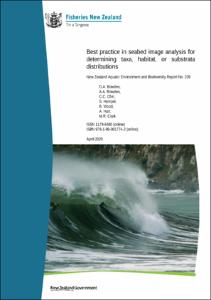| dc.contributor.author | Bowden, D.A. | |
| dc.contributor.author | Rowden, A.A. | |
| dc.contributor.author | Chin, C.C. | |
| dc.contributor.author | Hempel, S. | |
| dc.contributor.author | Wood, B. | |
| dc.contributor.author | Hart, A. | |
| dc.contributor.author | Clark, M.R. | |
| dc.coverage.spatial | New Zealand waters | en_US |
| dc.date.accessioned | 2023-05-31T16:38:29Z | |
| dc.date.available | 2023-05-31T16:38:29Z | |
| dc.date.issued | 2020 | |
| dc.identifier.citation | Bowden, D.A., Rowden, A.A., Chin, C., Hempel, S., Wood, B., Hart, A. and Clark, M.R. (2020) Best practice in seabed image analysis for determining taxa, habitat, or substrata distributions. Wellington, N.Z., Ministry of Primary Industries, 61pp. (New Zealand Aquatic Environment and Biodiversity Report No. 239). DOI: http://dx.doi.org/10.25607/OBP-1908 | en_US |
| dc.identifier.isbn | ISBN 978-1-99-001774-2 (online) | |
| dc.identifier.uri | https://repository.oceanbestpractices.org/handle/11329/2240 | |
| dc.identifier.uri | http://dx.doi.org/10.25607/OBP-1908 | |
| dc.description.abstract | This is a review of seabed imaging survey methods and their application in New Zealand, focusing on the deep sea and covering the fields of image acquisition, data extraction from imagery, and data management. The potential of new technologies and analysis methods, including machine learning techniques, is explored, and several areas are identified in which changes to current practices would improve the quality, quantity, consistency, and accessibility of seabed image-derived data.
Photographic surveying of the seabed is the only non-destructive sampling method available to us that generates quantitative data on fauna, habitats, and substrata at spatial scales relevant to exploration and management of New Zealand’s Exclusive Economic Zone. These characteristics become increasingly valuable as greater emphasis is placed on spatial management of benthic impacts and seabed resources in the New Zealand region. The past decade has seen increasing use of seabed imaging surveys and it is now an accepted method for characterising and mapping distributions of fauna and habitats, particularly in the deep sea beyond coastal waters. However, image acquisition methods in New Zealand remain limited and applications of image-derived data at wider spatial and temporal scales can be confounded by project-specific variations in analysis methods and data management. Here, the current state of seabed imaging survey methods in New Zealand is reviewed, focussing on their use in the deep sea and in relation to practices currently in use or in development elsewhere in the world, with the aim of identifying best-practice across the three stages of the imaging survey process: image acquisition, data extraction from imagery, and data management.
Several areas are identified in which present practice hampers wider use of image-derived seabed data, and changes are proposed to improve the quality, quantity, consistency, and accessibility of these data. Key changes suggested include: expanding the range of underwater platforms available in New Zealand for high quality seabed image acquisition; developing capability to make accurate 3-dimensional measurements from imagery routinely; establishing a coherent, stable library of annotation labels and reference images for fauna and substrata, with direct linkage to globally-accepted classification hierarchies; adoption of web-based annotation tools that enable multi-analyst input, consistent data management, and robust auditing; collaboration with existing initiatives to develop machine learning tools and suitable image libraries on which to train them; and development of long-term data management structures for seabed image data.
The present inability to exploit the full potential of seabed imagery results from lack of a strategic approach to investment in the necessary technological and data management frameworks. This issue is a consequence of the relatively recent development of broad-scale image surveying in the region, and the absence of accepted standards for image acquisition, types, and formats of data to be extracted, and structures in which these data are to be stored. Some of these issues are being addressed at present at the research institute-level, with adoption of more efficient annotation tools and development of dedicated databases for image-derived data. However, if seabed imaging is to be used to its full potential to inform environmental management at the scale of the Exclusive Economic Zone, there needs to be national strategic investment in the development of imaging systems and commitment by government agencies that use seabed image data to support integrated best practice in data management. These issues are strategic because long-term support for maintenance of databases is imperative and the costs of remotely-operated and autonomous imaging platforms that will be key to achieving more nuanced understanding of seabed resources and impacts might need to be viewed as national-level investments. | en_US |
| dc.language.iso | en | en_US |
| dc.publisher | Ministry for Primary Industries | en_US |
| dc.relation.ispartofseries | New Zealand Aquatic Environment and Biodiversity Report; AEBR-239 | |
| dc.subject.other | Seabed imagery | en_US |
| dc.subject.other | Benthic habitat | en_US |
| dc.subject.other | Benthos | en_US |
| dc.title | Best practice in seabed image analysis for determining taxa, habitat, or substrata distributions. | en_US |
| dc.type | Report | en_US |
| dc.description.status | Published | en_US |
| dc.format.pages | 61pp. | en_US |
| dc.description.refereed | Refereed | en_US |
| dc.publisher.place | Wellington, N.Z. | en_US |
| dc.subject.parameterDiscipline | Underwater photography | en_US |
| dc.subject.instrumentType | underwater cameras | en_US |
| dc.subject.dmProcesses | Data analysis | en_US |
| dc.subject.dmProcesses | Data acquisition | en_US |
| dc.rights.license | Crown Copyright | |
| dc.description.currentstatus | Current | en_US |
| dc.description.sdg | 14.a | en_US |
| dc.description.maturitylevel | Mature | en_US |
| dc.description.adoption | Organisational | en_US |
| dc.description.adoption | National | en_US |
| dc.description.methodologyType | Method | en_US |
| dc.description.methodologyType | Specification of criteria | en_US |
| obps.contact.contactemail | brand@mpi.govt.nz | |
| obps.resourceurl.publisher | https://fs.fish.govt.nz/Doc/24797/AEBR-239-Best-Practice-In-Seabed-Image-Analysis.pdf.ashx | |
 Repository of community practices in Ocean Research, Applications and Data/Information Management
Repository of community practices in Ocean Research, Applications and Data/Information Management
